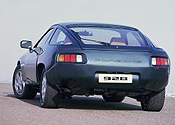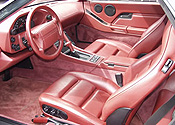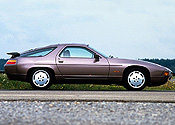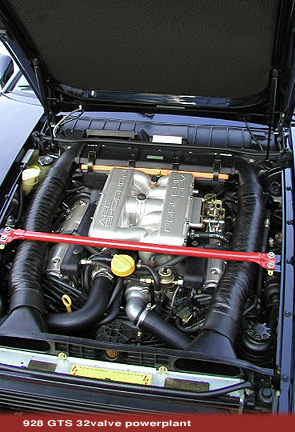



Porsche
928
By
the late 1960s, Porsche had changed significantly as a company, and executives
including owner Ferry Porsche were toying with the idea of adding a luxury
touring car to the line-up. Managing Director Ernst Fuhrmann was also
pressuring Ferdinand to "greenlight" development of the new
model in light of concerns that the current flagship at the time, the
911, was quickly reaching its maximum potential where it could soon no
longer be improved upon. Slumping sales of the 911 seemed to confirm that
the model was approaching the end of its economical life cycle. Fuhrmann
envisioned the new range-topping model as being the best possible combination
of a sports coupe and a luxury sedan, something well equipped and comfortable
enough to be easily driven over long distances that also had the power,
poise and handling prowess necessary to be driven like a sports car. This
set it apart from the 911, which was a pure sports car.
Ordered by Ferry Porsche to come up with a production-feasible concept
for his new model, Fuhrmann initiated a design study in 1971, eventually
taking from the process the final specs for the 928. Several drivetrain
layouts were considered during early development, including rear and mid-engined
designs, but most were dismissed because of technical and/or legistative
difficulties. Having the engine, transmission, catalytic converter(s)
and exhaust all cramped into a small rear engine bay made emission and
noise control more difficult, something Porsche was already facing problems
with on the 911 and wanted to avoid. After deciding that the mid-engine
layout didn't allow enough room in the passenger compartment, a front
engine/rear wheel drive layout was chosen. Porsche also feared at the
time that the U.S. government would ban the sale of rear-engined cars
in response to the consumer outrage over the Chevrolet Corvair, started
by Ralph Nader via his book "Unsafe at Any Speed".
Porsche engineers wanted a large-displacement motor to power the 928,
and prototype units were built with a 5.0 L V8 producing close to 300
hp. Very early units used one four-barrel carburetor, which was eventually
tossed in favor of Bosch's K-Jetronic fuel injection system. When increasing
concern within the company over the pricing and availability of fuel during
the oil crisis of the 1970s became an issue of contention, smaller engines
were considered in the interest of fuel economy. Some managers began pushing
for development of a 3.3 L 180 hp powerplant they had drawn up specs for,
but company engineers balked at this suggestion. Both sides finally settled
on a 4.5 L, SOHC 16-valve V8 producing 240 hp (219 in North America),
which they considered to have an acceptable compromise of performance
and fuel economy.
The finished car debuted at the 1977 Geneva Motor Show before going on
sale later that year as a 1978 model. Although it won early acclaim for
its comfort and power, sales were slow. Base prices were much higher than
that of the previous range-topping model and its larger size and somewhat
odd futuristic styling put off many purists who were more attracted to
the compact and efficient 911 sports car.
Fuhrman's replacment, Peter Schutz, decided that the models should be
sold side by side, feeling that the 911 still had potential in the company's
line-up. Legislation against rear-engined vehicles also didn't materialize.
Although the 928 developed an avid fan following, it never sold in the
numbers that Fuhrmann had originally predicted and was discontinued in
1995.
 The
928 featured a large, front-mounted and water-cooled, V8 engine driving
the rear wheels. Originally displacing 4.5 L and featuring a single overhead
camshaft, it produced 219 hp (163 kW/222 PS) for the North American market
and 240 PS (176 kW/237 hp) in other markets. Porsche upgraded the engine
from mechanical to electronic fuel injection in 1980, although power remained
the same. This design marked a major change in direction for Porsche (started
with the introduction of the 924 in 1976), whose cars had until then used
only rear- or mid-mounted air-cooled flat engines with four or six cylinders.
The
928 featured a large, front-mounted and water-cooled, V8 engine driving
the rear wheels. Originally displacing 4.5 L and featuring a single overhead
camshaft, it produced 219 hp (163 kW/222 PS) for the North American market
and 240 PS (176 kW/237 hp) in other markets. Porsche upgraded the engine
from mechanical to electronic fuel injection in 1980, although power remained
the same. This design marked a major change in direction for Porsche (started
with the introduction of the 924 in 1976), whose cars had until then used
only rear- or mid-mounted air-cooled flat engines with four or six cylinders.
Porsche utilized a transaxle in the 928 to help achieve 50/50 front/rear
weight distribution, aiding the car's balance. Although it weighed more
than the difficult to handle 911, its more neutral weight balance and
higher power output gave it similar performance on the track in the hands
of all but the most skilled drivers. The 928 was regarded as the more
relaxing car to drive at the time. It came with either a five-speed dog
leg manual transmission, or a Mercedes-Benz-derived automatic transmission,
originally with three speeds, later with four. Most cars were specified
with the automatic transmission.
The body, styled by Wolfgang Möbius under guidance of Anatole Lapine,
was mainly galvanised steel, but the doors, front fenders, rear hatch
and hood were aluminium. It had a substantial luggage area accessed via
a large hatchback. The new polyurethane elastic bumpers were integrated
into the nose and tail and covered in body-coloured plastic; an unusual
feature for the time that aided the car visually and reduced its drag.
Porsche opted not to offer a convertible variant but some aftermarket
modifiers offer convertible conversions.
The 928 qualified as a 2+2, having two small seats in the rear. Both rear
seats could be folded down to enlarge the luggage area, and both the front
and rear seats had sun visors for occupants. The 928 was also the first
vehicle in which the instrument binnacle moved with the adjustable steering
wheel. The 928 included several other innovations such as the "Weissach
Axle", an early all-wheel steering system that provides passive rear-wheel
steering in certain off-throttle cornering situations, and an unsleeved,
silicon alloy engine block made of aluminium, which reduced weight and
provided a highly durable cylinder bore.
Porsche introduced a refreshed 928S into the European market in 1980,
although it was 1983 before the model reached North America. Externally,
the S wore new front and rear spoilers and sported wider wheels and tires
than the older variant, but the main change for the 928S was under the
hood, where a revised 4.7 L engine was used. European versions debuted
with 300 PS (221 kW/297 hp), and were upgraded to 310 PS (228 kW/306 hp)
for the 1984 model year. North American spec models needed additional
emissions regulation equipment, and were limited to 234 hp (174 kW/237
PS) as a result.
Porsche updated the North American 928S for 1985, replacing the 4.7 L,
SOHC engine with a new 5.0 L, DOHC unit sporting four valves per cylinder
and producing 288 hp (215 kW/292 PS). Seats were also updated to new style.
European models kept the older 4.7 L engine as standard which was slightly
more powerful; the 32-valve engine became optional in some European countries
for 1986. That same year, revised suspension settings and larger brakes
with 4-piston calipers became standard on the 928S, marking its final
changes before becoming the S4.
The 928 S4 variant debuted for the second half of the 1986 as 1987 model,
sporting a new single-disc clutch, an updated version of the 5.0 L V8
for both the European and American markets producing 320 PS (235 kW/316
hp), regardless of where it was purchased, and fairly significant styling
updates which gave the car a cleaner, sleeker look. A significantly lighter
weight 928 Club Sport variant became available to continental Europe in
1988, while an S4 Sport (sometimes called SE), a sort of halfway point
between normally equipt S4 and much more race-oriented Club Sport became
available to the UK.
The S4 was kept in production through 1991. Porsche also debuted a more
sporting version, the 928 GT, in the spring of 1989. In terms of equipment,
the GT was most like the 928 Sport, having more equipment than a Club
Sport model but less than a 928 S4 so as to keep the weight down. 1989
GT had the ZF 40% limited-slip differential as standard like in Club Sport
and S4 Sport before it. For 1990 Porsche made 0-100% variable ratio limited-slip
called PSD (Porsche SperrDifferential) standard in both GT and S4. System
is much like the one from the 959 for helping give the vehicle even more
grip. Drivers who wanted to shift themselves would need to get the GT
model as S4 wasn't available with manual gearbox after the GT was introduced.
The S4 and GT variants were both cut in 1991, making way for the final
version of the 928. The 928 GTS debuted in late 1991 as a 1992 model in
Europe and in spring of 1992 as a 1993 model in North America. Smoother
bodywork, an updated interior, larger front brakes and new, more powerful
5.4 L motor making 350 PS (257 kW/345 hp) were the big advertised changes;
what Porsche wasn't advertising was the price. Loaded GTS models could
eclipse $100,000 USD in 1995, making them among the most expensive cars
on the road at the time. This severely hampered sales despite the model's
high competancy and long standard equipment list. Porsche discontinued
the GTS model that year after shipping only 77 of them to the United States.
Of the 77, 71 were equipped with automatic transmissions and 6 were manuals.
Total worldwide production for all years was little over 61000 cars.
copyright © 2003-2015 Lüfteknic | privacy | web terms | sale terms | info@lufteknic.com